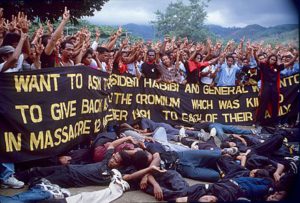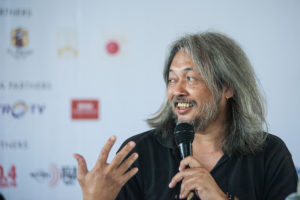Christie Cheng is currently enrolled in the Masters in Cultural Studies programme at SOAS and is particularly interested in understanding contemporary Southeast Asian cultural production through film and literature. Prior to her MA course, she read English Literature at the National University of Singapore and worked as an Arts Manager for the Literary Arts Department at National Arts Council, Singapore.
Re-cognising Constructions of Violent ‘Truths’ in Seno Gumiro Ajidarma’s “The Incident”

Ajidarma The Incident – Mark Rhomberg
Weaving actual testimonies of the 1991 Dili massacre in Timor-Leste into its narrative, Seno Gumiro Ajidarma’s short story, “The Incident”, masquerades “raw accounts” (2000, p. 205) as fiction, in order to evade censorship and expose the extent of Indonesia’s colonial military brutality. And yet, information gathered from these testimonies remains biased and inconsistent. In revealing the very inadequacy of these supposedly unadulterated accounts, “Incident”, I contend, exemplifies the very constructed-ness of truth, in particular, totalising narratives legitimising the savage violence wreaked on the native Timorese.
The multi-faceted expositions of the massacre documented in “Incident” that seemingly render the story non-partisan, neither criticising nor supporting the military, nonetheless amalgamates to no epistemological certainty of the events that transpired during the massacre. Although most eyewitnesses agree that the “soldiers […] carried out the massacre” against the innocent demonstrators (p. 204), the governor blames the “gangs [for being] the driving force behind the November incident”, whose “emergence [cannot] be traced to military policy” (p. 210). The general however charges the marchers instead, for “waving machetes and guns” at the soldiers and initiating the bloodbath (p. 212). Even among reports tracing the military’s violence, there are discrepancies: while one student maintains that soldiers “carried long knives” and “bayonets”, “stabbing in every direction” (p. 204), another businessman claims that no “knives” or “sharp weapons [were used] at the site of the incident” (p. 207).
In Ajidarma’s story, recurring details of the military’s brutality among the first eight reports come to frame our understanding of, and hence effecting suspicion towards the general and governor’s claims. In privileging the critics’ testimonies as such, “Incident” inadvertently draws attention to how “completely different” these “raw accounts” are compared to “news about war in the daily papers and on TV […] filtered and cleaned up” (p. 205), that are comparable with the apologists’ anecdotes. Moreover, the eight testimonies, “though difficult to confirm” (p. 213), are also imposed onto the English report, its the censored gaps interpolated with interpretations directed against the military.

Ajidarma – c. Anggara Mahendra _ Ubud Writers & Readers Festival
As with the gaps, the “cut off” letters “misplaced” for security reasons” that the narrator underlines invites readers to actively interrogate available reports and supposedly totalising constructions of reality (p. 210). For Ajidarma, changing the “format” in which “facts are framed”, does not lead to the discovery of reality, but rather, its construction and constructed-ness of partial truths (1998, p. 168). In “Incident” then, the narrator’s interjections not only elicit how easily reports may be tampered with, they also destabilise any seamless narratives that lull readers into complacency and accepting their ‘truths’ without discernment.
And yet, the narrator appears apathetic towards the brutality outlined by the eyewitnesses, musing about jazz instead. In subsuming the reports within the jazz discourse however, “Incident”, as Bodden affirms, uses the “universalized, over-arching figure [of jazz] in the novel for the expression of pain” (2002, p. 318). Wondering, “What song might Chick Corea write if he heard this story? I smell the odor of putrefying blood” (Ajidarma 2000, p. 208), the narrator appears to use Corea’s music to introduce sympathy towards the Dili victims—opinions which he is forbidden to publicise, but forced to reduce to physical senses, gesturing towards the inadequacy of any alleged objective narratives that speak objectively for the Dili victims.
In incorporating the eyewitnesses’ reports within the narrator’s stream-of-consciousness, “Incident” draws attention to the disjuncture between his aloofness and the harrowing reports he is perusing. Through his insouciance nonetheless, “Incident” impels the habituated perceiver to re-cognise the absurdity of normalised violence that has “become [Indonesian] culture” (Ajidarma 1998, p. 171), and therefore gain clarity of the legitimised violence enacted against the Timorese. To conclude, “Incident” does not appear to be as vested in recuperating truth, as it is prompting readers to see reality in brackets (1998, p. 169)—that is, (reality)—embedded within, but simultaneously constructed and foregrounded through its parenthetical frames, and in doing so, recuperate moral acumen and sensitivity towards the Dili victims.
Ajidarma, S. G., 2000. “The Incident.” Manoa, 12(1), 203-213.
Ajidarma, S. G., 1999. “Fiction, Journalism, History: A Process of Self-Correction,” trans. M. Bodden. Indonesia, 68, 164-171.
Bodden, M., 2002. “Satuan-satuan kecil and uncomfortable improvisations.” In: K. Foulcher and T. Day, eds., 2002 Clearing a Space: Postcolonial Readings of Modern Indonesian Literature. Leiden: KITVV, 293-324.


Leave A Comment